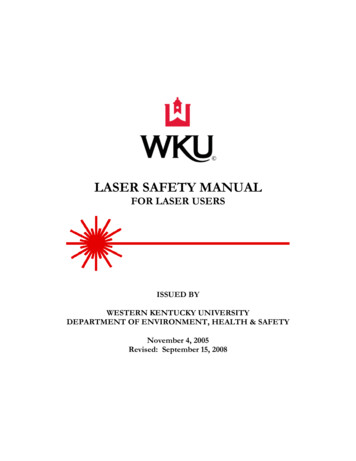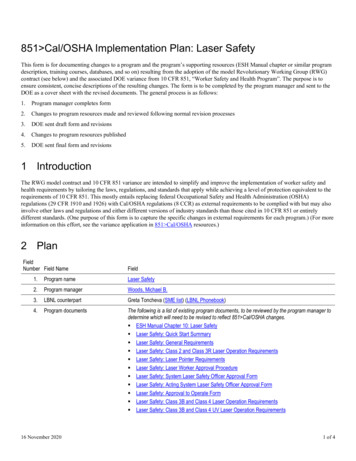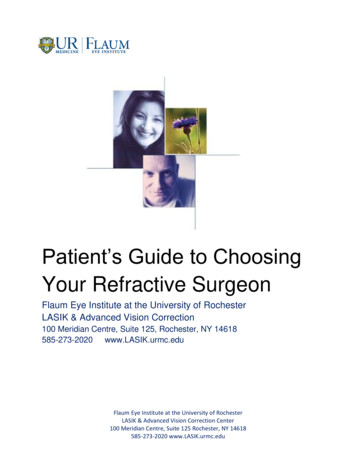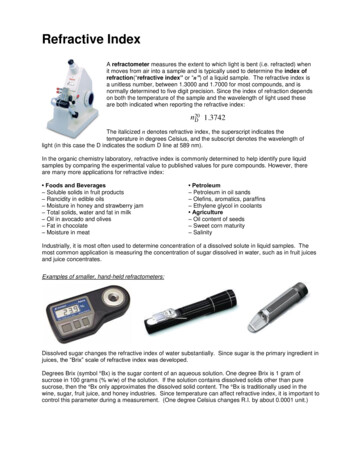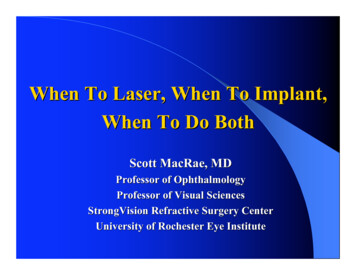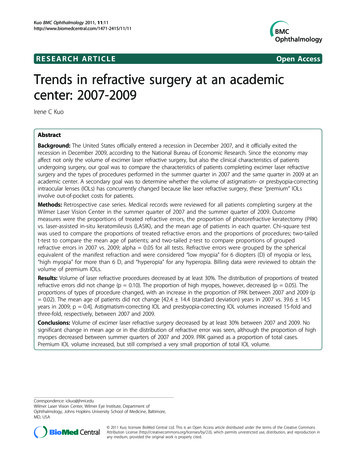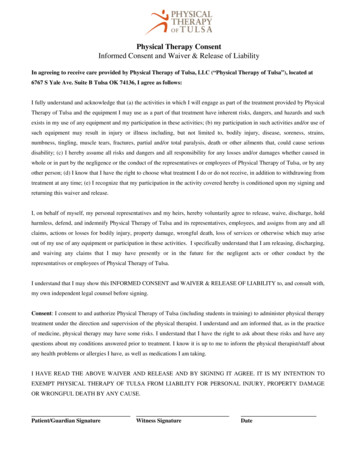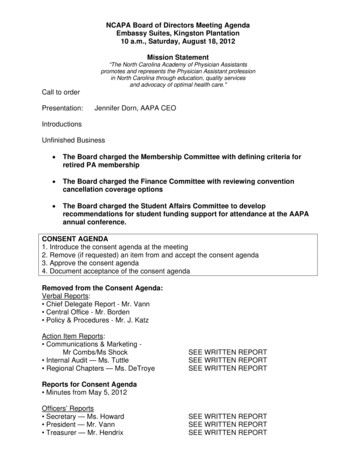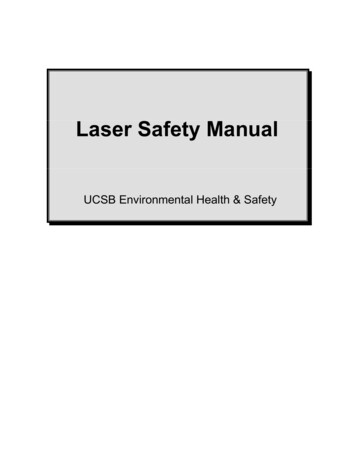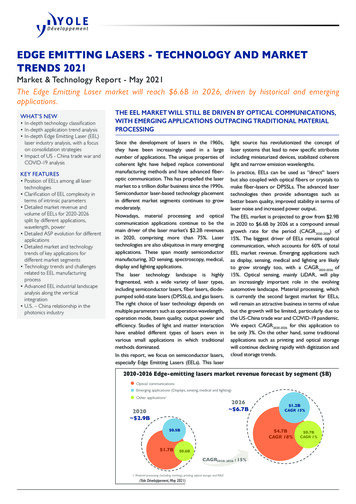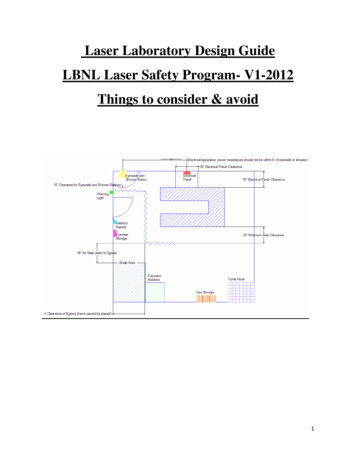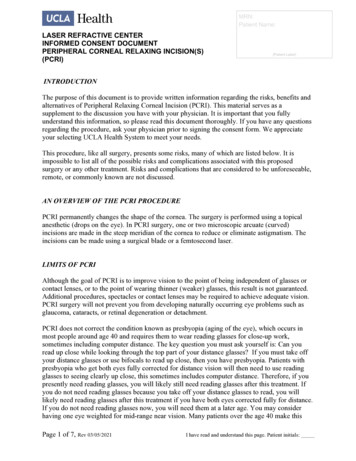
Transcription
MRN:Patient Name:LASER REFRACTIVE CENTERINFORMED CONSENT DOCUMENTPERIPHERAL CORNEAL RELAXING INCISION(S)(PCRI)(Patient Label)INTRODUCTIONThe purpose of this document is to provide written information regarding the risks, benefits andalternatives of Peripheral Relaxing Corneal Incision (PCRI). This material serves as asupplement to the discussion you have with your physician. It is important that you fullyunderstand this information, so please read this document thoroughly. If you have any questionsregarding the procedure, ask your physician prior to signing the consent form. We appreciateyour selecting UCLA Health System to meet your needs.This procedure, like all surgery, presents some risks, many of which are listed below. It isimpossible to list all of the possible risks and complications associated with this proposedsurgery or any other treatment. Risks and complications that are considered to be unforeseeable,remote, or commonly known are not discussed.AN OVERVIEW OF THE PCRI PROCEDUREPCRI permanently changes the shape of the cornea. The surgery is performed using a topicalanesthetic (drops on the eye). In PCRI surgery, one or two microscopic arcuate (curved)incisions are made in the steep meridian of the cornea to reduce or eliminate astigmatism. Theincisions can be made using a surgical blade or a femtosecond laser.LIMITS OF PCRIAlthough the goal of PCRI is to improve vision to the point of being independent of glasses orcontact lenses, or to the point of wearing thinner (weaker) glasses, this result is not guaranteed.Additional procedures, spectacles or contact lenses may be required to achieve adequate vision.PCRI surgery will not prevent you from developing naturally occurring eye problems such asglaucoma, cataracts, or retinal degeneration or detachment.PCRI does not correct the condition known as presbyopia (aging of the eye), which occurs inmost people around age 40 and requires them to wear reading glasses for close-up work,sometimes including computer distance. The key question you must ask yourself is: Can youread up close while looking through the top part of your distance glasses? If you must take offyour distance glasses or use bifocals to read up close, then you have presbyopia. Patients withpresbyopia who get both eyes fully corrected for distance vision will then need to use readingglasses to seeing clearly up close, this sometimes includes computer distance. Therefore, if youpresently need reading glasses, you will likely still need reading glasses after this treatment. Ifyou do not need reading glasses because you take off your distance glasses to read, you willlikely need reading glasses after this treatment if you have both eyes corrected fully for distance.If you do not need reading glasses now, you will need them at a later age. You may considerhaving one eye weighted for mid-range near vision. Many patients over the age 40 make thisPage 1 of 7, Rev 03/05/2021I have read and understand this page. Patient initials:
MRN:Patient Name:LASER REFRACTIVE CENTERINFORMED CONSENT DOCUMENTPERIPHERAL CORNEAL RELAXING INCISION(S)(PCRI)(Patient Label)decision and are extremely pleased with both their distance and mid-range near vision (example:computer screen, shopping tags, grocery shelves) and then use simple reading glasses for closerange and for smaller printed materials (example: newspapers, some magazines, mobile phone).ALTERNATIVES TO PCRIIf you decide not to have PCRI, there are other methods of correcting your nearsightedness,farsightedness or astigmatism. These alternatives include, among others, eyeglasses, contactlenses, and other refractive surgical procedures.RISKS AND CONTRAINDICATIONSRisks: The risks of PCRI surgery include, but are not limited to: Loss of Vision: PCRI surgery can possibly cause loss of best-corrected vision. This can bedue to infection (internal or external), scarring or other causes. Unless successfullycontrolled by antibiotics, steroids, or other necessary treatment, it could even cause loss ofthe infected eye. Vision loss can be due to the cornea healing with an irregular surface,which could cause astigmatism and make wearing glasses or contact lenses necessary.Irregular cornea healing could result in an uneven corneal surface so that distorted vision or“ghosting” occurs. This could mean that glasses or contact lenses may not correct the visionto the level and/or quality possible before undergoing PCRI. Visual Side Effects: Some patients experience light sensitivity, glare, halos or starburstsfrom light sources, particularly the first few months after the procedure. This may limit yourability to drive, particularly at night. These symptoms generally resolve in 3-6 months, butcan persist indefinitely. Residual nearsightedness, farsightedness and/or astigmatism: It is not possible to predicthow your eye will respond to this procedure. As a result, it may be that the PCRI surgerywill not give you the result you desired. It is possible that you still need eyeglasses or contactlenses after this procedure to obtain good vision because of residual nearsightedness and/orastigmatism. It is also possible that you are overcorrected, resulting in farsightedness(hyperopia) with/without astigmatism. This could mean that you need glasses for distanceand near vision. The results of your surgery can also regress over time. In many patients, thevision stabilizes in several months and remains stable. However, your vision can change atany time after the procedure and become either more near-sighted or more far-sighted. Youmay eventually need glasses even if you did not need them initially following the PCRIprocedure. In some, but not all cases, re-treatment, glasses or contact lenses could beeffective in correcting vision. Contact lens intolerance: If you wear contact lenses now, there is a chance you may not beable to do so after surgery because of the changes to the shape of your eye.Page 2 of 7, Rev 03/05/2021I have read and understand this page. Patient initials:
MRN:Patient Name:LASER REFRACTIVE CENTERINFORMED CONSENT DOCUMENTPERIPHERAL CORNEAL RELAXING INCISION(S)(PCRI)(Patient Label) Other Risks: Rarely, a serious complication may occur as a result of this procedure such asan infection of the eye, a corneal ulcer, inflammation of the eye, perforation of the corneapossibly requiring sutures; cornea scarring; endothelial cell loss (loss of cell density in theinner layer of the cornea, possibly resulting in corneal swelling); ptosis (droopy eyelid);blepharitis (inflammation of eyelids or scaly eyelids); rosacea (eyelid nodules); formation ofnew corneal blood vessels (neovascularization), diminished depth perception; double vision;corneal epithelial (skin) abrasion or defect which can slow the recovery process and maylead to reoccurring corneal erosions (outer surface cell detachment) with eye discomfort andblurred vision. While many of these complications are treatable with restoration of goodvision, PCRI can result in partial or complete loss of vision in the eye. This procedure canweaken the eye, making it more susceptible to severe trauma. If you have had previous eyesurgery it is possible that during the procedure that the incisions could re-open. This coulddecrease the healing and lead to irregular healing. A contact lens may need to be worn as abandage until the incisions close. In a rare case sutures may be required to close theincisions. In a very rare case a cornea transplant may be needed to restore useful vision. Later-Discovered Complications: You should be aware that other complications mightoccur that have not yet been reported. Longer-term results may reveal additional risks andcomplications. After the procedure, you should continue to have routine check ups to assessthe condition of your eyes. Risks of Not Undergoing PCRI: The risks of not having the surgery are limited to thoseassociated with your current visual condition. These include but are not limited to thedangers that may be associated with losing glasses or contact lenses, the risks of cornealdistortion and/or infection from wearing contact lenses, and the risks of trauma to the eyecaused by breakage of plastic spectacles or contact lenses in the eye.You may choose to have this procedure performed on both eyes at the same time. This willreduce your total recovery time and minimize the unbalance between eyes. However, treatmentof both eyes could lead to complications, as discussed above, occurring in both eyes at the sametime. Also, if you have both eyes treated at the same time, your vision may be blurred, in botheyes, making it harder to drive and function for a period of time afterward.Contraindications: The treatment should not be performed on persons: with uncontrolled vascular disease;with uncontrolled autoimmune disease;who are immune-compromised or on drugs or therapy that suppress the immune system;who are pregnant, nursing, or expecting to become pregnant within the six months followingthe PCRI procedure;with residual, recurrent, or active ocular disease(s) or abnormality except for myopiawith/without astigmatism, hyperopia with/without astigmatism or presbyopia in either eye;Page 3 of 7, Rev 03/05/2021I have read and understand this page. Patient initials:
MRN:Patient Name:LASER REFRACTIVE CENTERINFORMED CONSENT DOCUMENTPERIPHERAL CORNEAL RELAXING INCISION(S)(PCRI) (Patient Label)with active or residual disease(s) likely to affect wound-healing capability;with unstable or uncontrolled diabetes;with progressive myopia or hyperopia;with uncontrolled glaucoma;with uncontrolled dry eyes or blepharitis.If you know that you have any of these conditions, you should inform your physician. Inaddition, if you have any other concerns or possible conditions that might affect your decision toundertake PCRI surgery, you should discuss them with your physician.PRE- AND POST- TREATMENT CAREBefore PCRI surgery: Pregnancy: Pregnancy could adversely affect your treatment result since your refractiveerror can fluctuate during pregnancy; In addition, pregnancy may affect your healingprocess, and some medications may pose a risk to an unborn or nursing child. If you arepregnant, or expecting to become pregnant, you should not undergo the PCRI procedure untilafter the pregnancy. Taking medications and allergies: You should inform your physician of any medicationsyou may be taking in order to account for the risk of allergic reactions, drug reactions, andother potential complications during the PCRI surgery and subsequent treatment. Contact lens wearers: Patients who wear gas-permeable or hard contact lenses mustcompletely stop wearing such lenses at least 3 weeks prior to the initial eligibilityexamination. (This period may be longer for some patients.) Patients who wear soft contactlenses must completely stop wearing their soft contact lenses at least 3 days prior to theeligibility examination. After the eligibility exam, you may wear your contacts up until 24hours prior to surgery.After PCRI surgery: Eye Protection: Avoid exposing the eye to tap water in the bath or shower, as suchnonsterile water may expose the eye to increased risks of infection. Wear sunglasses duringthe first day after having surgery. The eye shield should be worn nightly for 1 week. Avoidrubbing the eye. Evidence has shown that, as with any other scar, the corneal incision willnot be as strong after healing as the original cornea was at the site of the incision. Therefore,the eye is somewhat more vulnerable to all varieties of injuries, particularly if you have hadother eye surgeries as well. You must wear protective eye wear when engaging in contact orracquet sports or other activities in which the possibility of a ball, projectile, elbow, fist orother traumatizing object contacting the eye may be high.Page 4 of 7, Rev 03/05/2021I have read and understand this page. Patient initials:
MRN:Patient Name:LASER REFRACTIVE CENTERINFORMED CONSENT DOCUMENTPERIPHERAL CORNEAL RELAXING INCISION(S)(PCRI)(Patient Label) Operating Motor Vehicles: After PCRI, glasses, contact lenses, eye drops, or othermeasures may be needed to operate motor vehicles safely. After surgery, you may experiencestarburst-like images or “halos” around lights, your depth perception may be slightly altered,and image sizes may appear slightly different. Some of these conditions may affect yourability to drive and judge distances. Driving should only be done when you are certain thatyour vision is adequate. On the day of the procedure and for your day one postoperativeappointment, you should arrange to have a driver. Pain and Discomfort: The amount of pain and discomfort that can be expected soon afterthe PCRI procedure varies with the individual. You should expect that the eye will be sore tosome extent after the surgery. Vision may be blurry, and you may experience some redness.Some patients report the sensation of a foreign object in the eye, itching, light sensitivity,tearing or dryness of the eye.PATIENT STATEMENT I have read this Informed Consent form (or it has been read to me). The PCRI procedure hasbeen explained to me in terms that I understand. I have been informed about the possible benefits and possible complications, risks,consequences, and contraindications associated with PCRI. I understand that it is impossiblefor my doctor to inform me of every conceivable complication that may occur, and theremay be unforeseen risks. I have been given the opportunity to ask questions and havereceived satisfactory answers to any questions I have asked. I understand that no guarantee ofa particular outcome was given and that my vision could become better or worse followingtreatment. My decision to undertake the PCRI procedure was made without duress of any kind. Iunderstand that the procedure is an elective procedure, and my astigmatism may be treatedby alternative means, such as spectacles, contact lenses, or other forms of refractive surgery.It is hoped that the PCRI will reduce or possibly eliminate my dependence on glasses orcontact lenses. I understand that the correction obtained may not be completely adequate andthat additional correction with glasses or contact lenses may be needed. I authorize the physicians and other health care personnel involved in performing my PCRIprocedure and in providing my pre- and post-procedure care to share with one another anyinformation relating to my health, my vision, or my procedure that they deem relevant toproviding me with care. I understand that my surgical measurements may be entered into a database (without anypersonally identifiable information) for the purposes of surgical planning, research,Page 5 of 7, Rev 03/05/2021I have read and understand this page. Patient initials:
MRN:Patient Name:LASER REFRACTIVE CENTERINFORMED CONSENT DOCUMENTPERIPHERAL CORNEAL RELAXING INCISION(S)(PCRI)(Patient Label)marketing and publication and that this non-identifiable data will be accessible to partiesoutside of UCLA. I have had sufficient time to review this consent form. A physician or an associate hasadequately addressed my questions and concerns. By signing below, I am making aninformed decision to undergo the PCRI procedure. I have received (or been offered) a copyof this consent for my own records. I authorize the release of my medical records in order to process medical claims or requestsfor further information from insurance companies. I understand that I have had an interpreter or legal guardian read this consent that they willsign under the surrogate consent area for me. I understand that if I elect to have another physician and/or optometrist (outside of UCLA)follow my postoperative care that I will sign the management consent form.I consent to have Dr. perform PCRI on my:(circle one) right eye/ left eye/ both eyes.Patient Printed NamePatient SignatureDateWitness Printed NameWitness SignaturePage 6 of 7, Rev 03/05/2021DateI have read and understand this page. Patient initials:
MRN:Patient Name:LASER REFRACTIVE CENTERINFORMED CONSENT DOCUMENTPERIPHERAL CORNEAL RELAXING INCISION(S)(PCRI)(Patient Label)FOR SURROGATE CONSENTI am the guardian, next-of-kin, or legal representative of the patient whose name appears aboveon the patient signature line. I have read and fully understand the foregoing information andhave discussed this information and its terms with the patient to the extent of the patient’sunderstanding. Due to the patient’s inability to provide informed consent, I consent to havePCRI performed on the patient’s right eye/ left eye/ both eyes.Printed Name of SurrogateSurrogate SignatureDateNature of Relationship to PatientWitness SignatureMANAGEMENT CONSENT FORMIt is my desire to have Doctor , perform mypreoperative/postoperative follow-up care for refractive surgery. I have been assured that UCLALaser Refractive Center will be contacted immediately if I experience any complications relatedto my eye surgery.Reason for Management by this doctor, is: (please check one)Maintain established eye care relationship.Difficult to return to UCLA for follow-up care because of location.Other (please give reason)Patient Signature DateWitness Signature DatePage 7 of 7, Rev 03/05/2021I have read and understand this page. Patient initials:
hours prior to surgery. After PCRI surgery: Eye Protection: Avoid exposing the eye to tap water in the bath or shower, as such nonsterile water may expose the eye to increased risks of infection. Wear sunglasses during the first day after having surgery. The eye shield should be worn nightly for 1 week. Avoid rubbing the eye.
